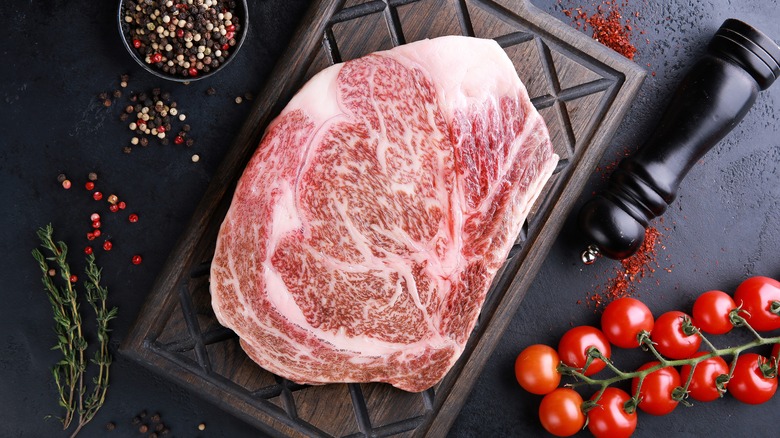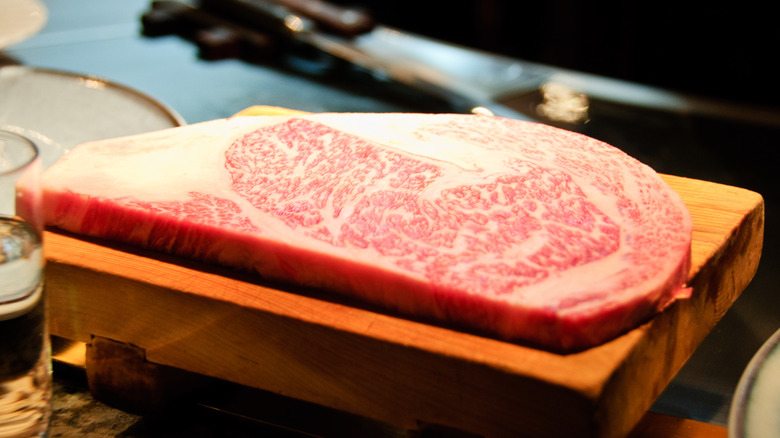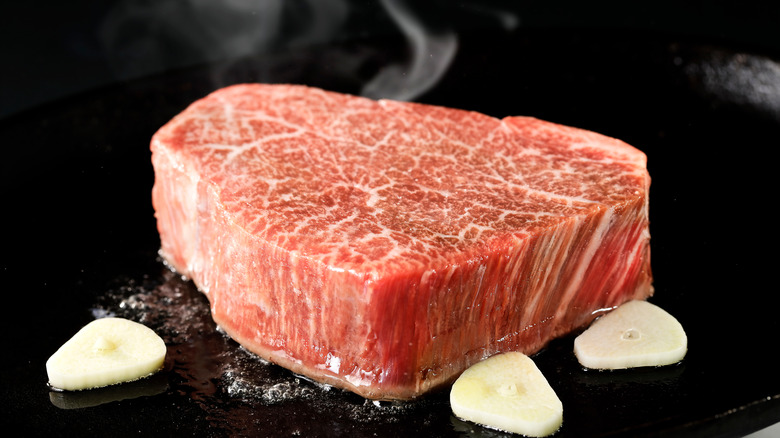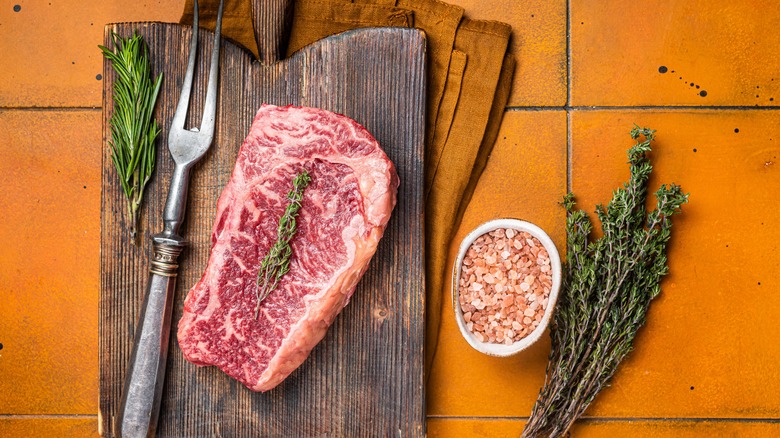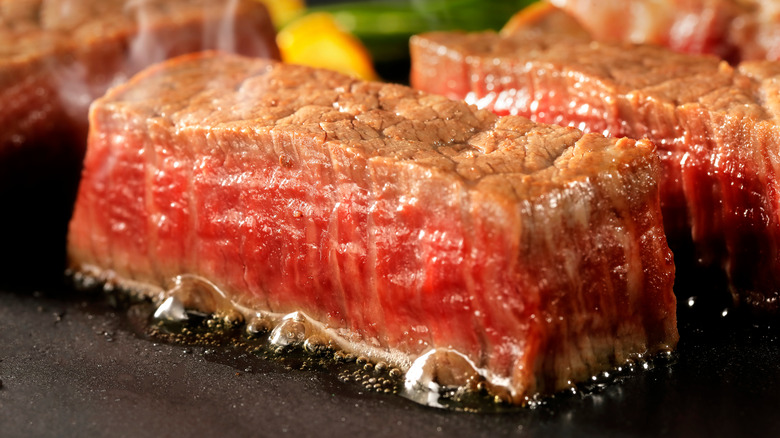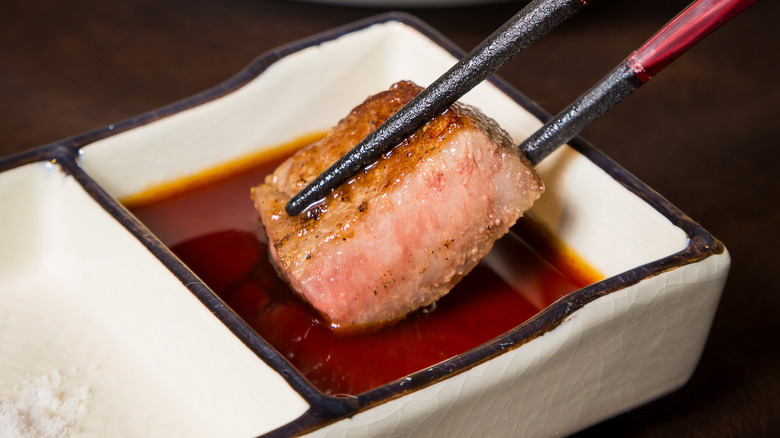5 Key Tips To Consider When Cooking Wagyu At Home
Japanese beef is some of the best in the world, with A5 Wagyu steak considered the height of luxury. While it's a treat to try an expertly-prepared piece of Wagyu in a restaurant, it's something that many home cooks are nervous about cooking at home — after all, getting it wrong is a costly mistake. To get some pro tips, Food Republic consulted chef Richie Wilson, the culinary director of Fire Steakhouse in Dublin, and co-chief of the World Steak Challenge competition.
It's often the case that different cuts of steak require different cooking techniques. Because of its extremely high fat content — A5 has a Beef Marbling Standard (BMS) score of eight to 12, whereas USDA Prime has a score of less than half of that — Wagyu needs a unique approach. That being said, cooking it doesn't have to be daunting. It doesn't require any complicated techniques or specialist equipment, and can be prepared in different ways. Wilson's advice is to "keep it as simple as possible," and his expert guidance can help you do just that. Here are the chef's top five tips to help you master this marbled meat.
Don't buy too much Wagyu at once
When choosing the perfect steak at the store, it's usually good to pick a large, thick cut, as it is less likely to overcook. But that's not the case with Wagyu. "If you're an absolute novice looking to cook Wagyu at home, my advice is to not buy too much," chef Richie Wilson advised. "You won't be eating the same kind of volume as if you were just buying a normal eight-ounce sirloin steak, say."
Because the steak tastes so incredibly rich and buttery thanks to its intramuscular fat, the suggested serving size of Wagyu is just one or two ounces per person. These steaks are best shared rather than trying to devour a whole one, which would be frankly overwhelming. And given that a 10-ounce A5 Wagyu ribeye steak can cost around $150 to buy, that's probably good news for your wallet as well as your palate.
Cook Wagyu at a lower temperature than regular steak
Steaks need a ripping-hot pan, right? Not so with Wagyu — you'll want to go a bit lower. "Because Wagyu is grain fed, that grain fed fat renders at a much lower temperature," explained Richie Wilson.
The chef suggested cooking the steak to a lower final temperature, too: "While you might want a regular steak medium rare at 52 degrees Celsius [126 degrees Fahrenheit], Wagyu is probably better at around 47 or 48 [116 to 118 degrees Fahrenheit]," he said.
Overcooking is the biggest mistake people make when cooking Wagyu, so what's the best way to avoid that? Wilson recommends using a plancha for a fast cook, if you have one, but "realistically, just use a skillet." He instructed to "Take a two-ounce wedge of Wagyu, sear it neatly on every edge, and it will be cooked straight away."
Season the steak right before you cook it
To avoid mistakes while cooking steak, common wisdom is to season your beef with salt well in advance — but once again, Wagyu plays by different rules. "With other steaks I'd probably season them 10 to 15 minutes before cooking, but with Wagyu I'd say only season it right before you cook it," advised Richie Wilson.
The reason for this last-minute approach is all to do with the fat ratio. "Salt draws out the moisture, and normally when we season steak in advance we know that that moisture is drawn back in by the muscle," explained Wilson. "Wagyu has very little muscle and more fat, so that salt is drawing out fat more than moisture, and it's not drawing it back into it." Don't be as generous with the seasoning as you usually would, either; Wilson suggests a light hand with the salt, and you'll still get a great crust.
How to grill Wagyu without flare-ups
Given the magnificent marbling that runs evenly throughout Wagyu steak, cooking it on the grill can be a risky option. Fat dripping down onto hot coals causes flare-ups, bursts of fire that can be dangerous or burn your food. "If you're grilling it, don't just put it straight on," advised chef Richie Wilson. He adds that "the char will completely overpower the natural flavor of the meat".
If you love the unique smoky flavor that grilling imparts, there is a way around the issue. "Use a flat top if you're grilling it," Wilson recommended. It's also advisable to cut up the meat into smaller chunks, which will cook faster, rather than putting a whole steak on the grill. Generally speaking, though, you'd probably only want to grill American Wagyu (which is usually crossbred with black Angus cattle) rather than the intensely fatty Japanese A5.
Try serving the steak simply dipped in soy
Once you've cooked your Wagyu — hopefully with more confidence if you've followed steak expert Richie Wilson's tips — then you'll want to fully appreciate the luxurious flavor of the meat. So, forget the usual steakhouse-style buttery sauces. "If it's your first time doing it at home, get yourself a little dish of sushi-grade soy and give it a little dip when you're eating it," advised Wilson. "You don't need to do anything else."
As for what to drink alongside it, white wine is the unexpected perfect pairing for Wagyu steak thanks to its high acidity which cuts through the fatty richness. If you prefer red, try a bright young Burgundy or a tannin-heavy Cabernet Sauvignon.

